Background and Childhood
Sindiso Mfenyana is descended from the Bhele clan, which is an offshoot of the Hlubi tribe. He traces his roots back to a small town nearAlice, where his ancestors most likely arrived with theiMfecane during the mid 1800s, fleeing from the wave ofShaka Zulu's territorial expansion. His paternal grandparents, Isabella (nee Ntshaba) and Samuel Mfenyana, received primary education at Indwe missionary school in the Eastern Cape. They had six children and Sindiso's father, Mtutzeli Naphtali Mfenyana, was born in 1908 along with a twin brother, who sadly passed away when he was just five years old.
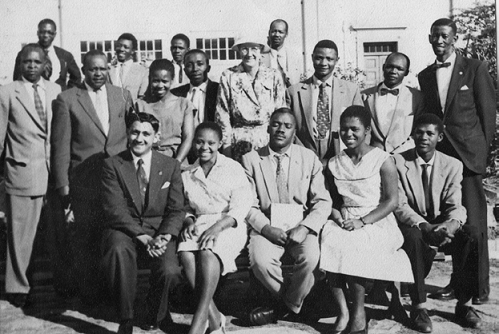 The Committee of the Students Christian Association (SCA). Mfenyana is seated on the extreme right.
The Committee of the Students Christian Association (SCA). Mfenyana is seated on the extreme right.
Naphtali began his primary education in 1915 but this was disrupted by an outbreak of typhoid fever in 1916. The family then moved towards the Glen Grey District (present day Cacadu). The family kept cattle and grew sorghum on their new homestead. Sindiso describes his father's upbringing in the present day Eastern Cape as traditional – in the parlance of the time the villagers around him may have been referred to as “Amaqaba” or “red,” which is to say that they held their traditional values to be sacred and were resistant to the urbanisation taking place in the cities of South Africa at the time. Sindiso's grandparents, however, were Christians, and as such they endeavoured to bring Christianity and Western education to their neighbours. They established a church and mobilised for the building of a school in the village too. Napthali went on to complete a teacher training course in 1928 and obtained a teaching post in Machubeni in 1929. He later registered for a Higher Teacher Training course atLovedale and finally went to Bolotwa to serve as the school principal in 1938. He married Sindiso's mother, a primary school teacher named Nombuyiselo Czarina Makalima, in 1939.
Sindiso was born 12 March 1940, in Bolotwa and spent his early years in Dophu. His early childhood was spent helping to herd cattle and enjoying the perks of a life lived out of doors. His spare time was spentstick fighting with his peers and enjoying traditional Xhosa ceremonies. When he was five years old, his father was ordained as a priest in the Anglican Church. Napthali’s first job post was at St. Phillip’s Church in Duncan Village, East London, and this is where Sindiso began his primary education. At the end of 1947, Sindiso’s family left East London forGrahamstown, where they moved into an old mission house, which had been previously occupied by the White priest there. After six months, however, the family had to move again for health reasons, to the railway hub of Noupoort in the Great Karoo. This was in June 1949. Noupoort was to be the site of Sindiso’s first intimation of whatApartheid meant in South Africa. The town was mixed but segregated, with the wealth very clearly distributed unevenly between the various racial groups; Whites with the most; Blacks with the least; Indians and Coloureds with something in between. Sindiso’s father helped to maintain the Anglican Mission there, presiding over services in both Xhosa and Afrikaans, trying to build bridges between the Coloured and Black communities. On 23 May 1951 Sindiso’s mother passed away. His father would, however, marry again in 1952. Sindiso retains fond memories of both women.
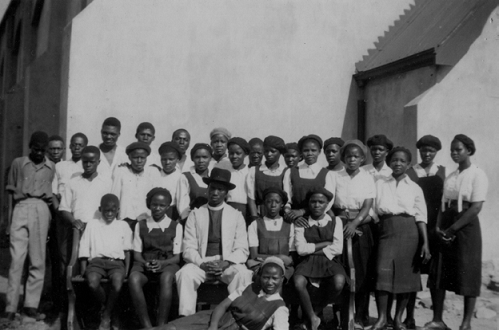 St.Agnes Anglican Church Choir, Noupoort, 1955. Mfenyana is 5th from the left in the back row.
St.Agnes Anglican Church Choir, Noupoort, 1955. Mfenyana is 5th from the left in the back row.
Sindiso’s earliest formal introduction to political thinking arrived in the form of a teacher named Bibi, while Sindiso was still in primary school. The lesson consisted of an alternative presentation of the Great Cattle Killing, the event which all but sealed the fate of Xhosa people in 1856-57. Received wisdom from colonialism-infused textbooks taught children that the Cattle Killing was an act of pure folly, dreamt up out of local superstition and executed with native hubris. The story Bibi told, however, provided a new angle: that at that time the British were trying to force the proud Xhosa into working under terrible conditions in the mines to unearth the country’s newly discovered mineral wealth. Rather than become wage labourers, the Xhosa preferred to remain self sufficient and farm their beloved cattle. The British were also increasingly frustrated by the power of native sangomas, and hence they hatched a plan to convince the youthful and naiveNongqawuse that she had been spoken to by the ancestors and commanded to report back with their bloodthirsty demands. Bibi suggested that the whole prophesy had been devised carefully by the British in order to break the Xhosa resistance. Whether Bibi’s version of events was true or not remains unknown. However, what is true is that for Sindiso, his eyes had just been opened to the fact that the received wisdom from colonial sources could be challenged and the myths, which African schoolchildren were being sold about themselves were often simply untrue.
In January 1952 Sindiso changed schools and enrolled as a boarder at St. James Primary school inCradock. One of his most vivid memories of Apartheid came when he was back home in Noupoort during school holidays. TheGroup Areas Act of 1950 had been encroaching on the lives of non-White South Africans ever since its inception, but for Sindiso it only made itself explicitly obvious for the first time half way through that decade. By then it suddenly became apparent in Noupoort that the White people of the town had been indoctrinated into believing that they were innately superior to any other race and even White boys of his own age suddenly demanded that Sindiso now referred to them as “Baas.”
The emergence of a new form of legislated racism in South Africa inevitably led to a new form of activism to counteract it. Thus it was that Sindiso recalls a formative event at school in Cradock, whereby prominentAfrican National Congress members one day came to address the pupils during an impromptu assembly. The speakers described to the pupils the plan for the ANCDefiance Campaign, in which Black people were encouraged to peacefully occupy White spaces in an act of open defiance of racist Apartheid laws. Sindiso remembers this rally as the first political rally he ever attended, and the beginning of his life-long support for the ANC.
As Sindiso got older his father entrusted him with certain of his pastoral duties as a priest, such as visiting nearby farming communities, conducting church services and presiding over funerals upon his father’s instruction. By 1953, he had passed his primary education with flying colours and was sent, under his father’s jurisdiction, to the Anglican St John’s College in Mthatha. Sindiso excelled in the formal environment of St John’s and by 1957 was the only matriculant at the school to obtain a first class pass with exemption.
Early Involvement with the ANC
In 1955, Sindiso began regularly attending meetings of theANC Youth League (ANCYL). By 1957 he had been elected as the ANCYL secretary of St John’s, while his friend, Edmund Mxolisi Mankazana, was elected chairman. This was to be the beginning of a long journey indeed connected to South Africa’s oldest liberation movement. Shortly afterwards, theCongress Alliance (composed of the ANC and its allies), announced the formation of the Freedom Charter, which the government immediately sought to suppress. This, coupled with a state visit by the minister of Native Affairs and future Prime Minister,Hendrik Verwoerd, to address tribal chiefs in Mthatha, were more than enough to persuade Sindiso that a radical form of resistance was required if Black South Africans were ever to carve out a means of dignified existence in their country. The next logical step for Sindiso, as an aspirant revolutionary, was therefore inevitably Fort Hare University, the place where the cream of ANCYL was based and the same university that would give the worldGovan Mbeki,Oliver Tambo,AC Jordan,Seretse Khama, Julius Nyerere,Robert Sobukwe,Robert Mugabe, Kenneth Kuanda,Desmond Tutu,Chris Hani, and most famously of all,Nelson Mandela.
Sindiso entered Fort Hare on a scholarship from the Mthatha Bunga (council of tribal chiefs) in 1957. He enrolled for a B.Sc and took classes in physics, chemistry, zoology, botany, and philosophy. Sindiso’s student career at Fort Hare took place at a complicated time for the university. The government had recently identified it as a hotbed for political dissent and sought to limit its influence. At the same time, a breakaway faction from the ANC was forming under the guidance of struggle stalwart, Robert Sobukwe, calling themselves thePan African Congress (PAC). For Sindiso, this was an exciting time, but also a dangerous one. On 21 March 1960, theSharpeville Massacre occurred in which 5000 people gathered outside of Johannesburg to demonstrate against the pass laws. Sixty nine peaceful protesters were murdered by police that day, precipitating the declaration of a national state of emergency and more upheaval. The PAC and ANC were both immediately banned and the ANCYL went underground to continue its activities. In 1960, the Apartheid government also officially took control of Fort Hare, placing it in the hands of the Department of Basic Education. In response, Sindiso, along with many other ANCYL members, began to reconcile themselves to the fact that a peaceful response to the iniquities of Apartheid was futile and if real change were to be affected, it would have to be through armed struggle.
In December 1960 during the Christmas vacations, Sindiso received a letter from none other than Govan Mbeki, who at the time was a member of the ANC executive in Port Elizabeth. The letter contained instructions for reporting to the house of Advocate Duma Nokwe in Orlando West and was effectively an invitation to joined the armed resistance that was brewing within the ANCYL at the time. With his father’s blessing, Sindiso boarded the train at Noupoort and headed for Johannesburg.
Johannesburg was a far bigger city than Sindiso had ever experienced before. Its streets; its diversity; and its energy were thrilling for the young cadre, and he soon fell into a happy routine helping to work as a roving messenger for the ANC. Amongst the ANC top brass that Sindiso met on that initial trip to Johannesburg were Walter Sisulu, Andre Nzo, Andrew Mlangeni, and Abel Mthembu, all of whom were in and out of the ANC’s offices at Macosa House. Indeed, Sisulu became something of a surrogate father to Sindiso at this time.
During his time in Johannesburg Sindiso attended fundraising stokvels and came to learn more intimately the workings and political motivations underpinning the work of the ANC. He also contributed to the struggle by helping to organise the All-in Africa Conference in 1961, at which the already legendary Nelson Mandela was the keynote speaker. The real reason for being being in Johannesburg, however, was to prepare Sindiso for exile. In December 1961, roughly one year after he had moved to Johannesburg, the ANC officially launched its armed wing, Umkhonto we Sizwe (MK). Along with eight other young recruits, the ANC finally deemed Sindiso ready to travel abroad for training. In January 1962, Sindiso and his cohort were called to a house in the middle of Johannesburg and asked to wait. To their surprise, the man who came to meet them was Nelson Mandela.
Sindiso recalls Mandela’s address to the youthful members:
“Look, the ANC is training soldiers, but there are other important tasks which educated young South Africans can do for the ANC. We want you to study in the Soviet Union. Your mission will be to find out how the Soviets are able to provide free education, free health services, very cheap housing and virtually free public transport to all citizens of the country. This is the knowledge we require if we are to implement the Freedom Charter.” [i]
While Sindiso and his colleagues were disappointed with not being sent for military training for the MK, they accepted the necessity that the strategy set out. On 5 January 1962 the group left Johannesburg and travelled overland to newly independent Tanganyika (Tanzania), where they boarded an aeroplane that would take them first to Nigeria, then London, and finally to the Soviet Union.
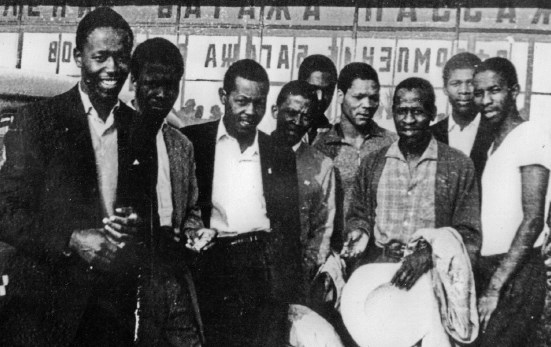 From left to right: Mandla Tshabalala, Sizakele Sigxashe, Anthony Mongalo, Cyril Phakedi, Zolile Ngcakani, Fanele Mbali, Koos Segola, myself and Monwabisi Jara. Kremlin, Moscow, 1963.
From left to right: Mandla Tshabalala, Sizakele Sigxashe, Anthony Mongalo, Cyril Phakedi, Zolile Ngcakani, Fanele Mbali, Koos Segola, myself and Monwabisi Jara. Kremlin, Moscow, 1963.
Exile
Once landed in Russia, the nine South Africans caught a bus to Kiev to begin an intensive language course over the following year. In Russia, the Soviets had a well established educational programme for political agitators from all across the globe. Thus, whilst stationed in Kiev, Sindiso found himself in the company of strangers from India, Cuba, Afghanistan and many other countries besides, all engaged in language learning and educational activities before going back to their home countries to shift the politics of their home nations. Sindiso was selected to study national economic planning at the Kiev Institute of National Economics (KINE)
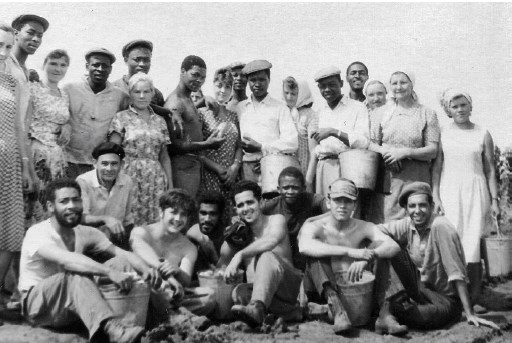 South African exiles with Cuban colleagues at collective farm. Crimea, Ukraine, 1962.
South African exiles with Cuban colleagues at collective farm. Crimea, Ukraine, 1962.
While in Russia, Sindiso also met his wife, a graduate in Aeronautical Engineering by the name of Rita. The two met one another while traveling by boat to a holiday resort on the Black Sea, and corresponded for several months through letters before finally tying the knot on 6 June 1963 in Kiev. One year later Rita gave birth to the couple’s son, Nikita Sindisovitch Mfenyana. In August 1967, Sindiso successfully graduated from KINE and was posted by the ANC to Hungary for the meeting of the Preparatory Committee for the World Youth and Students Festival.
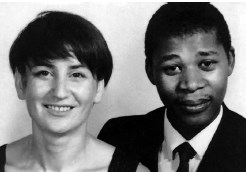 Rita and Sindiso
Rita and Sindiso
Sindiso moved to Budapest with his wife and young child in August 1967. He would remain there for three years, working for the World Federation of Democratic Youth (WFDY). His work for the WFDY required a lot of international travel, and meant that Sindiso was able to visit different countries on the African continent, as well as in the rest of the world. He also began to get his first taste of international diplomacy, participating in roundtable discussions about imperialism, the spread of capitalism, and foreign affairs in general. He retained this post until the end of August 1970, when he departed with his family Hungary for Cairo to take up the position of ANC representative in Egypt.
In Cairo, Sindiso was based at the African Association in the isle suburb of Zamalek, which also housed the offices of liberation movements from Angola, Mozambique, Zimbabwe, and Namibia. As the ANC’s chief representative in Egypt, Sindiso continued his diplomatic travels to various conferences and delegations (Liberia, Sierra Leone, Guinea, Iraq, Syria, Jordan and many more) during this period. For this purpose he was granted an Egyptian passport to add to his growing collection. By this stage Sindiso had travelled on South African, Tanzanian, Sierra Leonean and Algerian passports in order to remain mobile. On one particular trip to Libya, Sindiso had the chance to meet with Colonel Muammar Gaddafi (who enjoyed the appellation, ‘Brother Leader’) during a convention of African Liberation Movements outside of Tripoli. As he addressed the assembled representatives, Gaddafi spoke about the various successes of decolonisation on the continent, but singled out South Africa, saying that until South Africans rejected the religion of their colonisers and adopted Africa’s “true religion” of Islam, they would not be free. After his address Sindiso asked Gaddafi to please elaborate on how adopting Islam would help South Africans, but Brother Leader simply reiterated that South Africans were enslaved by foreign beliefs and would not be free until they saw the light.
Following tireless work in Cairo, in the second half of 1974, Sindiso was transferred to the ANC headquarters in Lusaka, Zambia. In Lusaka at that time, the bulk of the ANC National Executive Committee (NEC) were also based. For instance, Alfred Nzo, Oliver Tambo, Thomas Nkobi, Duma Nokwe, Joe Nodise, Johnny Makatini, Josiah Jele, Thabo Mbeki, Sizakele Sigxashe and Sipho Makana were all based there. Whilst in Lusaka, Rita formally registered as a member of the ANC and Nikita began Standard 5 at Lusaka Boys School. Sindiso continued to work for the ANC but in order to support himself he took a job lecturing in agricultural economics at the University of Zambia. This spell in academia however, did not last long. Soon after he began, the 1976 Soweto Uprising occurred and the ANC in exile saw its numbers swell as young people from South Africa left in droves to escape the increased police brutality. To accommodate the burgeoning number of new cadres, the ANC in exile decided to establish a school in the Morogoro region of Tanzania. The school was inaugurated in 1979 and named the Solomon Mahlangu Freedom College.
In 1978 Sindiso returned to the Soviet Union to complete a three-month long military officers’ course. When he came back to Zambia, the ANC’s Secretary General, Alfred Nzo informed him that he was to head up a newly created Department of Professional Bodies, which was intended to spearhead the creation of ANC departments of Education, Health, Arts and Culture, and Legal and Economic Units. Although victory remained a long way off, the ANC was already maneuvering itself to become a government-in-waiting and Sindiso was thus charged with the task of facilitating its transformation from a politico-military organisation into a well-prepared political party. Spurred on by the success of the Lancaster House negotiations (which began in 1979), by 1984 the aforementioned ANC departments were up and running.
In 1985, Sindiso was appointed Secretary to (ANC President) Oliver Tambo, with whom he enjoyed a close relationship until he was deployed to the German Democratic Republic (GDR), where he acted as chief representative of the ANC.
[insert picture p238 with caption - replace ‘author’ with ‘Sindiso’]
Sindiso’s role in the GDR soon came to resemble that of diplomatic attaché. He occupied an office in East Berlin where he was able to receive ANC members and other members connected to the cause. At this period Sindiso also joined the South African Communist Party so as to broaden his connection to other components of the liberation struggle. After a successful three years in East Germany, Sindiso again returned to Zambia in 1988 and began working as an administrative secretary for Alfred Nzo. By this time, it was becoming clear that South Africa was on the cusp of a profound change - and when the Rivonia trialists were finally released in November 1989, there was a palpable sense that liberation was around the corner. In early 1990 when the trialists arrived in Lusaka, it was Sindiso who first entered their aeroplane to welcome them on behalf of the ANC in exile in Zambia.
Return to South Africa
In December 1990, as the ANC and Apartheid government began to discuss a future peaceful transition of power, Sindiso was called upon, in his capacity as a member of the ANC’s National Executive Committee (NEC), to attend talks in Johannesburg. It was the first time he was able to return home in 28 years! Rita was also able to return with him as she was called upon to attend the first ANC Women’s League conference in Kimberley. After their business with the ANC was attended to, Sindiso and Rita travelled by bus from Johannesburg to Mthatha and Queenstown. It was the first time that Rita could meet Sindiso’s family, and she was welcomed into the family fold in traditional Xhosa fashion. [ii] However, these were busy, urgent times for the ANC’s top brass, and five days later the couple were back in Johannesburg for meetings and workshops. A few days later Rita returned to Zambia while Sindiso undertook an unexpected trip with Nelson Mandela.
Since the time of Mandela’s release on 11 February 1990, he had been flat out preparing the way, not only for South Africa and the ANC, but for the whole world to witness the country’s democratic transition. Implicit in this mission was a serious amount of international travel. Thus, it was not completely out of the blue that Sindiso found himself swept up on one of Mandela’s diplomatic whistle stop tours, and the one he found himself accompanying was to Gabon and the People’s Republic of Congo. Aside from Mandela himself, other members of the party included Miriam Makeba, Jessie Duarte, and Billy Modise.
Meanwhile back in Zambia, the mood amongst ANC cadres in exile was fast becoming a heady cocktail of expectation, elation, and impatience. The most pressing concern on everybody’s lips, however, was naturally, “When are we going home?” It would take a small while longer though for the ANC structures in South Africa to prepare the ground sufficiently for these exiled comrades to return in a manner that would not leave them wholly dependent on their families and lost in the rapidly changed and changing state. The breakthrough for these comrades finally came during the Arusha Donor’s conference in February 1991. It was at this conference that practical plans of action were confirmed so that shortly afterwards, in June, the repatriation of all ANC members could at last take place.
Sindiso’s first house as a returnee was located in Berea in Johannesburg’s CBD. For the returnees to South Africa, the change of lifestyle required quite an adjustment. Although MK cadres received an allowance and assistance from the ANC, the South Africa to which they returned was often a far cry from the South Africa which they had left behind. Sindiso’s experience was no different in this regard; simple civilian tasks like opening a bank account or taking out car insurance were novelties which suddenly had to be learnt.
One particularly moving moment for Sindiso came when he returned to his childhood home of Noupoort. To his considerable surprise, the ANC’s influence had reached even this sleepy dorp during his absence and thus Sindiso was received as nothing less than a local national hero when he revisited town.
Civil Service Years
Along with a number of other ANC members who had been part of the NEC in exile, Sindiso did not return to an NEC position upon arriving back permanently in South Africa. Instead he put the NEC the following proposal: that in order to prepare for the smooth running of government office, himself along with the other members of the NEC in exile (who were not elected to NEC positions in South Africa), should go for top quality Civil Service training. Fortunately, when Sindiso to his proposal to the head of the ANC, Nelson Mandela, it was heartily approved of.
In the event, it was decided that Sindiso and his comrades ought to go for training in two countries with a very strong tradition of governmental civil servants. Thus is was decided that they go for training in the UK and the United States. In 1992, Sindiso along with Josiah Jele, Antony Mongalo, Stanley Mabizela, Sipho Makana, Eddie Funde (all ANC), and three other non ANC members commenced Civil Service training, first at the British Civil Service College in London, and subsequently the US Civil Service College in Pennsylvania.
Aside from trying to implement a working civil service, Sindiso also spent the years 1992-93 engaged in political firefighting, especially trying to quell interparty (mainly ANC-IFP) disputes. His work also involved providing clarity about the ANC’s policies and role in the liberation struggle, including enlightening people about the distinctions between the ANC and the SACP; a relationship which, after years of anti-communist propaganda, clearly made many would-be ANC voters feel uneasy.
In March 1994, just before South Africa’s first democratic elections, Sindiso was appointed Under Secretary to the National Assembly and he moved to Cape Town. Preparation for his new role began immediately, with getting to know his way around the various departments of Parliament. By the time the first democratic election took place on April 27 1994, Sindiso was the only Black person at senior management level. He was in Parliament to witness the first address of the new President, Nelson Mandela, as well as the special addresses of numerous international heads of state, including the Queen of England, Bill Clinton, Yasser Arafat, and Fidel Castro.
In June 1997, Sindiso was the first Black person to ever be appointed Full Secretary to Parliament in South Africa. In his first year he achieved the ANC target of having an equal balance of 50 percent men and women and an 80:20 percent ratio of Black to White staff. He was also responsible for deciding on the type of Parliament which would serve the new South Africa, borrowing certain traditions from the Westminster system, but remaining loyal to an African sense of ownership and identity. He was also responsible for insourcing the parliamentary catering staff. Sindiso remained a Parliamentary employee until 2004, and in 2006 he received an award for meritorious service from the South African Legislatures Secretaries Association.
Sindiso’s one major regret about the transition to democracy, is the way that the national education portfolio was handled. To Sindiso’s mind, it was the unfortunate circumstance of having vastly experienced former exiles overlooked in favour of ambitious, young domestic members of the ANC when appointing staff to senior governmental posts in education that set this process in motion. Whilst there was a need to satisfy the various levels of struggle participation, this sometimes resulted in the best candidates being pushed aside to make way for the “inziles” who had never left. [iii]
Diplomacy
After leaving Parliament, Sindiso went to the Minister of Foreign Affairs who was, at the time, Dr Nkosazana Dlamini-Zuma, and requested a diplomatic post, preferably on the continent. Luckily for him, a position had just opened up in Tanzania. He was the third South African ambassador to the country (like most African countries, Tanzania did not have diplomatic relations with Apartheid South Africa).
In 2007 Sindiso returned to South Africa for the ANC’s annual conference in Polokwane. To his dismay, the ANC he saw on display was much changed from the one he had dedicated his life to. Moreover, he was exposed to alarming stories from his comrades about their treatment at the hands of the ANC youth. It was following this experience that he became one one of the founding members of the ANC Veteran’s League, a place where the veteran’s could hold their own meetings and not “be insulted and disregarded.” [iv]
In 2017 Sindiso submitted the manuscript of his biography, “Walking with Giants” to SAHO for publication, and the book can be purchased on the SAHO website by visiting our online shop here.
Endnotes
[1] Ibid 115 ↵
[2] Ibid 262 ↵
[3] Ibid 293 ↵
[4] Ibid 30 ↵